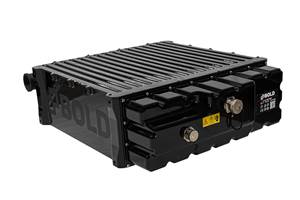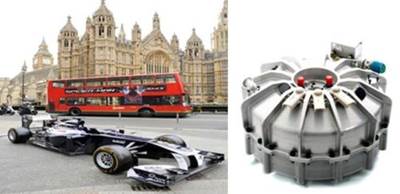Energiestro co-founders Anne and André Gennesseaux (pictured) aimed to produce an affordable, scalable version of a flywheel energy storage system for use with renewable energy sources. The prototype solution they’ve developed and plan to commercialize is enabled by filament-wound glass fiber for prestressing a concrete rotor (at right). Source (All Images) | Energiestro
(Essert, France) was founded in 2001 by Anne and André Gennesseaux, with the goal of commercializing affordable energy storage technology for the renewable energy sector.
Deciding that modern batteries are too costly, too difficult to recycle and reliant on too many rare metals, the startup team turned to flywheel energy storage systems, which store and release energy through electrically rotating a cylindrical rotor (the flywheel itself) at high speed. In this type of system, the motor, alternator and flywheel are often encased in a vacuum chamber to help reduce friction during rotation.
Early flywheel energy storage systems were all-metal designs, followed by newer, more efficient carbon fiber composite versions that rely on carbon fiber’s lower weight and higher tensile strength versus steel to spin faster and therefore store more energy for the same mass.
However, carbon fiber composite flywheels can be costly, and Energiestro sought to develop a more affordable solution that could be used for underground energy storage connected to at-home solar panels. “There’s a very high demand for storing solar energy at very low costs,” explains André Gennesseaux, who is currently the company’s CTO and COO.
The cheapest solution they found? Concrete. “However, we quickly realized you cannot use concrete alone to make a flywheel, because concrete doesn’t resist traction from external forces,” Gennesseaux explains, which in turn makes its rotation less efficient and leaves it prone to cracks. One solution, as in many construction applications, was to prestress — or compress — the concrete to strengthen the concrete flywheel and increase its resistance to external forces.
To do this, Energiestro turned to the idea of overwrapping the flywheel with a composite layer — glass fiber to keep costs as low as possible — to create the needed compression without adding a lot of additional weight.
“We had a lot of design challenges in getting to the final product, because we were using a material combination that hadn’t been tried before in this type of application,” Gennesseaux says.
The flywheel system Energiestro developed differs from other versions of this technology in several ways, perhaps most importantly in the materials used to manufacture the rotating cylindrical rotor that is key to the system. To keep costs low, Energiestro uses concrete and glass fiber as an alternative to metal or carbon fiber. Source | Energiestro and Olivier Fournier (illustration)
Filament winding was the most obvious manufacturing method for overwrapping the 1-meter-diameter, 1.4-meter-tall cylindrical flywheel. However, Gennesseaux says that the team was unable to find a commercial winding system that could meet the tension requirements of up to 1,000 MPa needed to compress the concrete.
Energiestro teamed up with filament winding specialist Autonational Composites (now part of Autonational Solutions B.V. after a 2024 acquisition by PM Group, Gorredijk, Netherlands) to build a customized winding system for this application.
The first challenge was that most filament winders are horizontally oriented, but a 3-ton, concrete flywheel is too heavy to easily lay on its side for horizontal winding. Step one was to adapt the system as a vertical winder while ensuring the resin still distributes and cures evenly without dripping. The system that was ultimately developed is positioned onto a crane for transport among flywheels.
Second, the goal was to use the least amount of glass fiber possible by maximizing the winding tension. “This is very difficult to do, but very important. If you use a lower tension, you have to use more layers of glass fiber, which makes the entire thing more expensive. Economically, it was very important to use the glass fiber at maximum tension. But the difficulty is that when you increase the tension, you have issues with glass fiber breaking,” Gennesseaux says.
A specialized vertical winder was developed to lay down the glass fiber at the correct tension without breakage along the height of the rotor.
To solve this issue, “we had to completely rethink the process of winding,” he says. This led to a patented design involving a series of 10 individual rollers that the strands of glass fiber wrap around before being fed onto the flywheel. The laid-down fiber is followed immediately by a spray nozzle applying liquid epoxy. “If you feed glass fiber too fast from zero to maximum stress, it breaks. In this case, the rollers are designed to more slowly increase the tension as the fiber moves along,” he says. The final component is cured at room temperature.
Gennesseaux adds that the system had to be designed with the relatively low modulus of glass fiber in mind as well. “When you go from low to high tension, the length of the glass fiber actually increases. At each step, we increase the diameter of the roller to match the increase in the length of the fiber.” To make each flywheel, the finished filament winding system lays up about 50 layers of glass fiber composite, approximately 2 centimeters thick.
The flywheel system is encased in a concrete canister and housed mostly underground near the solar panel site.
The team ultimately succeeded in manufacturing a prestressed concrete/glass fiber composite flywheel that, when operating in the storage system, can currently store up to 10 kilowatt-hours of energy from solar panels — enough to provide power to a home through the night after collecting energy during the day. Energiestro plans to advance to larger systems for up to 50 kilowatt-hours of energy storage.
The company’s VOSS (“Volant de Stockage Solaire” or “Solar Storage Flywheel”) product, including the prestressed concrete/glass fiber composite flywheel, is designed to be mostly buried underground within a concrete canister in the yard of a home or business with solar panels, with an access hatch aboveground to enable maintenance. The system is designed to last up 30 years or more, Gennesseaux adds.
Does VOSS meet the cost requirements that Energiestro set out for? According to Gennesseaux, the cost of concrete per kilowatt-hour of energy stored is about €20 with the VOSS system, which he claims is about 10% of the cost of an equivalent carbon fiber flywheel or lithium battery system.
As of early 2025, Energiestro has two beta test systems installed with commercial and industrial solar panel systems, and has 10 more planned for installation this year. These are manufactured at the company’s pilot plant in France. “We are fundraising now to build a larger factory so we can produce at scale,” Gennesseaux says. The company hopes to be able to begin commercial production in 2027.
When producing systems at scale, Energiestro plans to work with local partners to sell VOSS systems to home consumers or businesses, with an ultimate goal of providing systems that can be used at large-scale solar plants, which Gennesseaux estimates would require about 10,000 systems per plant.
“This development has already been 10 years in the making. No one had made a flywheel with concrete and glass [fiber] like this before, which led to development of the winding technology to build it,” he says. “But now we are up and running, are seeing success, and are ready to build a factory and begin producing these at scale.”
Related Content
Polaris Spaceplanes receives MIRA II, MIRA III fiberglass airframes
German aerospace startup prepares next demonstrators toward reusable space launch and hypersonic transport toward routine, low-cost and safe access to space.
Read MoreJEC World 2025 highlights: Evolving recycling and biomaterials technologies
CW technical editor Hannah Mason shares sustainability-focused composites trade show highlights featuring maturation, scale-up, new partnerships, and new technologies in biomaterials and recycling.
Read MoreAviation-specific battery system uses advanced composites to address electric, hybrid flight
BOLDair’s composite enclosure, compression structures and thermal runaway management enables high-performance electric energy storage.
Read MoreOwens Corning initiates review of strategic alternatives for glass fiber business
Owens Corning considers alternative options like a potential sale or spin-off as part of its transformative move to strengthen its position in building and construction materials.
Read MoreRead Next
DecomBlades project lays groundwork for wind recycling commercialization efforts
The three-year project, led by composites industry partners and research institutes, announced breakthrough progress in finding cost-effective recycling paths for decommissioned blades.
Read MoreComposite flywheels: Finally picking up speed?
A wave of new composite flywheel developments for bus, rail, auto, heavy truck, construction equipment, and power grid support promises fuel savings, improved efficiency and reduced emissions — i.e. sustainability in the global quest for more energy.
Read MoreCTL webinar presents HAWK project findings for airborne wind energy systems
Event featured insights from project partners regarding novel materials testing, addressing technical challenges and the path to certification to better understand AWE systems and their potential.
Read More
.jpg;width=70;height=70;mode=crop)












